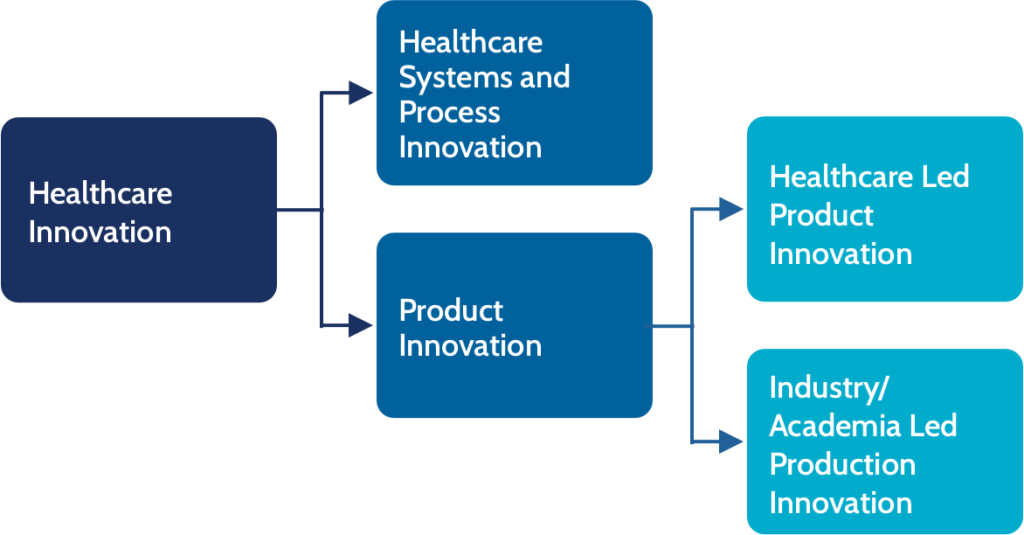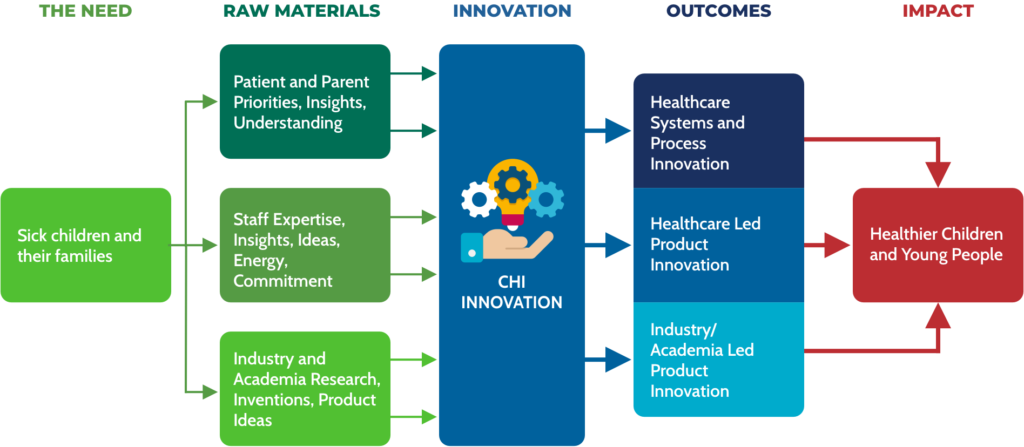5
Introduction &
Background.
What is Innovation?
The term ‘innovation’ is used in popular language as a noun referring to a new idea, device, or method (countable noun) or the act or process of introducing new ideas, devices or methods (uncountable noun) that add value to a product, service or process. The very broad and general definition introduces difficulties when we try to be specific about innovation in healthcare. A review of the relevant information and literature on innovation in healthcare in the public realm confirms the lack of a standardised definition and wide variation in the effective meaning of the term ‘innovation’. For the purposes of this document and our future work in this area it is important that we are clear on what innovation means in our specific context.
Innovation in CHI is taken to refer to new ideas, empathetically generated, that can be implemented to solve healthcare problems.
There are four key aspects to this:
-
Novelty:
The ideas represent a new way of doing something. -
Empathy:
Ideas are generated through collaboration with the end user - usually patients, parents, staff.
-
Feasibility:
Solutions can be practically implemented into healthcare. -
Impact:
The design of solutions should be centred around the impact that they will have on child health and wellbeing.
Innovation is not the same as merely having new ideas or doing new things. To produce an innovation that makes a difference in solving a problem, several steps, based on the principles of design thinking, are required:
Design thinking principles

Empathise
Involve and ask the people who are impacted by the problem

Define
Clearly define what the problem is

Ideate
Put a process in place to generate ideas to solve the problem

Prototype
Design of a solution for the problem

Test
Test the solution in the real world
While some useful new approaches/solutions to healthcare problems can be arrived at without a formal process around innovation, having a structured organisational approach to arriving at an innovation (innovation practice) will encourage more staff to take on innovation projects, increase the likelihood of success for teams trying to solve complex healthcare problems and improve the quality and applicability of the solutions. Principles of innovation practice are relevant no matter what type of innovation is involved, and well organised and structured support services for innovation will ensure that the potential for innovations across an organisation is optimised.
Types of Innovation
In the commercial world, innovation can be broadly viewed as encompassing two key areas: Product innovation (new products or services) and process innovation (new ways to produce products or deliver services). If we look at this from a health system perspective, we can understand the common types of healthcare innovation:
Healthcare systems and
process innovation:
This involves improving the way we deliver healthcare and can range from designing more efficient hospital systems and operational management to the design of physical spaces to the direct organisation, delivery and content of clinical care.
Healthcare Product
Innovation:
The delivery of new products or technologies in healthcare. This can come from patients and healthcare staff seeing and understanding a clinical care need (healthcare led product innovation) or from industry or academic partners with new inventions with the potential to address healthcare needs (industry/academia led product innovation).
Types of Healthcare Innovation

Innovation in Healthcare
It is generally understood that innovation in healthcare is a good thing, that it is valued and sought after by healthcare organisations given its association with improvements in the standard of care delivered to patients. The predominant manifestations in public facing media of innovation in healthcare revolve around product innovations, many of which have been delivered as a result of translation of basic or applied research (generally referred to as technology transfer). While some of these new technologies, devices or treatments have been arrived at by a process involving innovation practice, many have not. The field of technology transfer tends to be well developed in many academic health science organisations, with universities often building considerable expertise in this area given the applicability to many areas outside of medicine and the potential for returns on research investments. This is a vital area for academic teaching hospitals to develop and maintain expertise in.
Process innovation in healthcare, although potentially very impactful for patients and parents receives less focus and attention. Since the problems that process innovations seek to address are often complex and multifaceted areas, one dimensional solutions generally tend to fail or work only temporarily, discouraging continued efforts. In order to successfully put solutions in place, organisations need a supportive innovation culture, access to innovation practice expertise and support, and the willingness and capability to implement solutions.
Process innovation and product innovation are equally important in healthcare. Rather than being distinct entities that are in competition for resources, considerable overlap exists between them, and similar skills, relationships and structures are required to effectively deliver them. In ensuring that all innovation activity is driven by empathy and focused on outcomes, effectively combining product and process innovation within healthcare organisations has the potential for significant impact for patients.
Translating the needs of children into
impactful innovations


